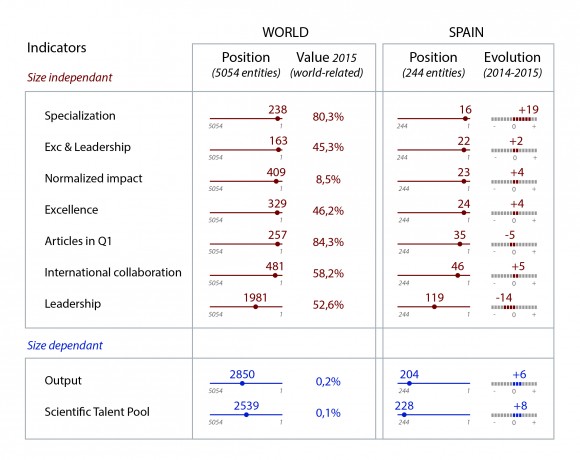CREAF has improved its scientific ranking with respect to other Spanish institutions, as measured by SCImago Institutions Rankings (SIR)
CREAF is among the 500 best international institutions of the world in six diferent indicators according to this ranking. Of the 244 ranked Spanish entities, four indicators place CREAF within the first 30 ranked positions

Since the last year CREAF has been included in the annual ranking carried out by SCImago Institutions Rankings (SIR) of the SCImago Research Group.
The SIR report is the most complete classification of its kind for the analysis of institutions’ research results.
Each year SCImago Research Group publishes a report based on different bibliometric indicators evaluating the performance of different research institutions worldwide, including their scientific output and level of excellence, among other factors. To be able to enter into the ranking it is necessary to have published at least 100 publications in journals indexed in the SCOPUS bibliographic repository in the final year of the 5-year period evaluated (this 2015, 2009-2013 was considered).
The 2015 SIR indexed a total of 5054 entities worldwide and 244 at the national level, including universities, biomedical centers, and research centers.
Output: Total number of documents published in scholarly journals indexed in Scopus (Romo-Fernández, et al., 2011). This is a size-dependent indicator.
International Collaboration: Institution’s output ratio produced in collaboration with foreign institutions. The values are computed by analyzing an institution’s output whose affiliations include more than one country address (Guerrero-Bote, Olmeda-Gómez and Moya- Anegón, 2013; Lancho-Barrantes, Guerrero-Bote and Moya-Anegón, 2013; Lancho-Barrantes, et al., 2013; Chinchilla-Rodríguez, et al., 2012). This is a size-independent indicator.
Normalized Impact: Normalized Impact of led output is computed using the methodology established by the Karolinska Intitutet in Sweden where it is named “Item oriented field normalized citation score average”. The normalization of the citation values is done on an individual article level. The values (in %) show the relationship between an institution’s average scientific impact and the world average set to a score of 1, –i.e. a NI score of 0.8 means the institution is cited 20% below world average and 1.3 means the institution is cited 30% above average (Rehn and Kronman, 2008; González-Pereira, Guerrero-Bote and Moya- Anegón, 2011).This is a size-independent indicator.
High Quality Publications: Ratio of publications that an institution publishes in the most influential scholarly journals of the world, those ranked in the first quartile (25%) in their categories as ordered by SCImago Journal Rank (SJRII) indicator (Miguel, Chinchilla-Rodríguez and Moya-Anegón, 2011). This is a size-independent indicator.
Specialization Index: The Specialization Index indicates the extent of thematic concentration /dispersion of an institution’s scientific output. Values range between 0 and 1, indicating generalist vs. specialized institutions respectively. This indicator is computed according to the Gini Index used in Economy (Moed, et. al., 2011; López-Illescas, Moya-Anegón and Moed, 2011; Arencibia-Jorge et al., 2012). In this indicator, when the value is 0 it means that the data are not sufficient to calculate. However, it should be noted that although the resulting specialization values range between 0 and 1, these values have been normalized on a scale of 0 to 100, as the rest of indicators. This indicator is size-independent.
Excellence Rate: Excellence rate indicates the amount (in %) of an institution’s scientific output that is included into the set of the 10% of the most cited papers in their respective scientific fields. It is a measure of high quality output of research institutions (SCImago Lab, 2011; Bornmann, Moya-Anegón and Leydesdorff, 2012; Guerrero-Bote and Moya-Anegón, 2012). This is a size-independent indicator.
Scientific Leadership: Leadership indicates the percentage of an institution’s output as main contributor, that is, the amount of papers in which the corresponding author belongs to the institution (Moya-Anegón, 2012; Moya-Anegón et. al, 2013; Moya-Anegón, et al.,). This is a size-independent indicator.
Excellence with Leadership: Excellence with Leadership indicates the amount of documents in the Excellence rate in which the institution is the main contributor (Moya-Anegón, et al., 2013). This is a size-independent indicator.
Scientific talent pool: Total number of authors from an institution in the total publication output of that institution during a particular period of time. This indicator is size-dependent.







